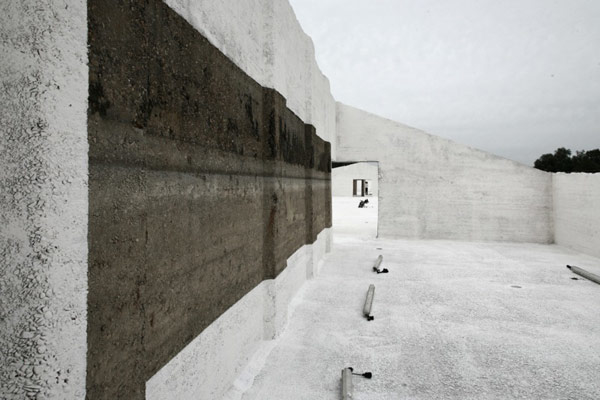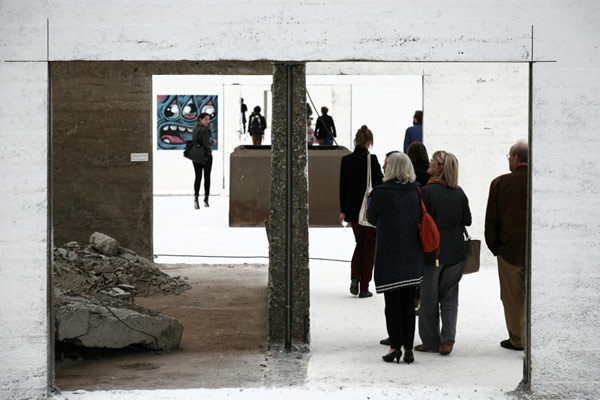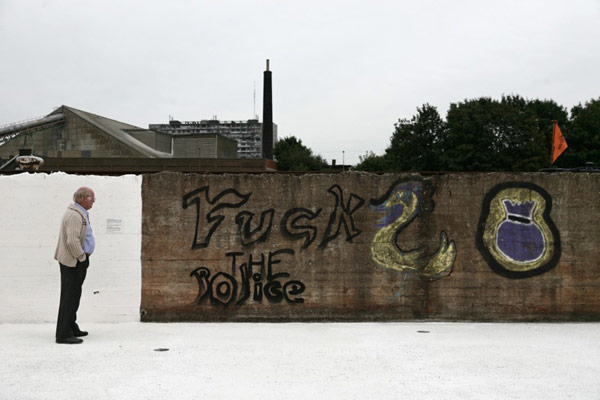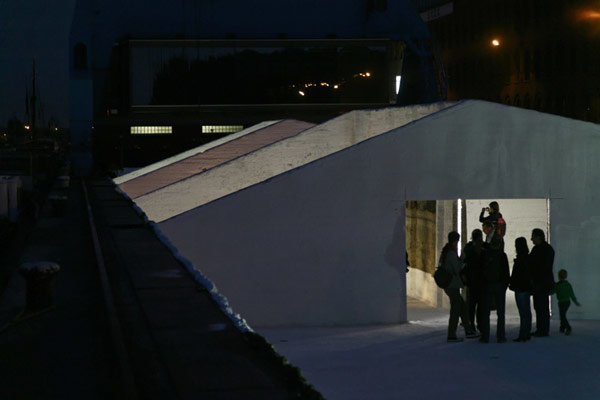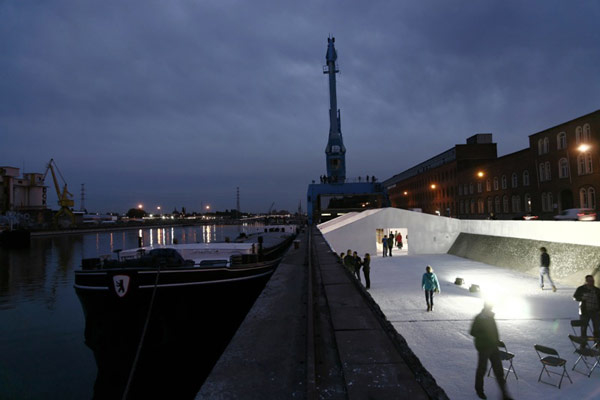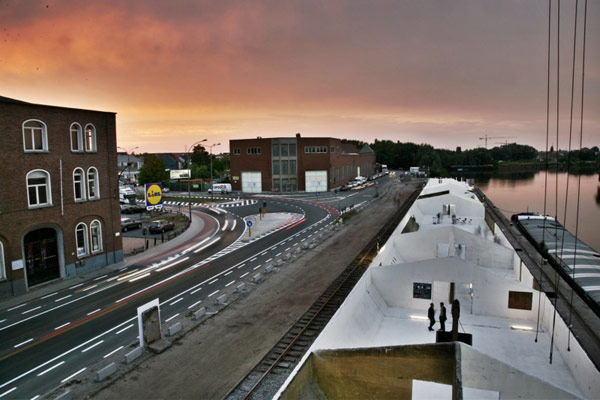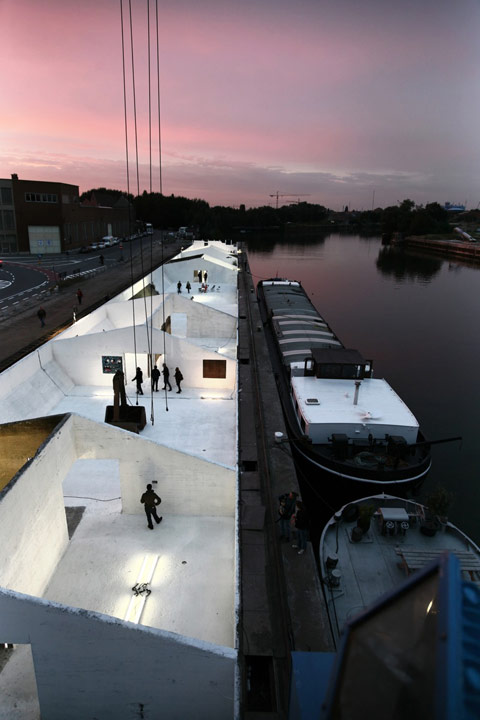Projekat: Tristan Boniver, Renaud Haerlingen, Lionel Billiet, Maarten Gielen
Projekat se odigrava na lokaciji koju su renovirali: Sarah Melsens i Roberta Gigante uz podršku AG SOB
Lokacija: Gent, Belgija
Foto: tekst i slike su objavljeni pod Creative Commons Attribution-Noncommercial-Share Alike 2.0 licencom od strane Rotor kolektiva.
Belgijski dizajnerski kolektiv Rotor uključio se u obnovu sada nefunkcionalnih depoa šljunka uz obalu kako bi se obeležili tragovi industrijske prošlosti grada Ghent.
Osnovan 2005. godine, Rotor je kolektiv koga čine ljudi koji dele interesovanje prema materijalnim tokovima u industriji i konstrukciji. U praksi, Rotor se bavi koncepcijama i realizacijom dizajnerskih i arhitektonskih projekata. U teoriji, Rotor razvija kritičko mišljenje prema dizajnu, materijalnim resursima, i otpadu kroz istraživanja, izložbe, pisane radove i konferencije.
http://rotordb.org/
Urađen je urbanistički plan za oblast dokova u gradu Ghent. Neki objekti će biti uklonjeni dok će se beton izlivati negde drugde, stanovnici obalne oblasti će upoznati nove susede i jučerašnje prakse će napraviti mesta za tekuće aktivnosti.
Prema ovom planu, betonska struktura dugačka 160m, Grindbakken, korišćena u prošlosti za transfer šljunka i peska između brodova i kamiona, je predviđena kao višenamenski prostor dostupan javnosti, opremljen vodom i strujom i ofarban u belo kao prazno platno za buduće aktivnosti.
Kada su nas angažovali da uradimo prvu intervenciju u ovom prostoru, odlučili smo se da se pozabavimo ovim procesom prefarbavanja. Izabrali smo i dokumentovali specifične zone interesovanja i urađeno je 36 ramova na lokaciji kako bi se ove zone zaštitile tokom procesa čišćenja i farbanja.
Ramovi nisu farbani; crvena boja nastala je drugim putem. Primarno, ovi depoi su služili za skladištenje šljunka i peska, međutim, nekada su korišćeni i kao privremeni depoi gvozdene rude. Kratko prisustvo ovih supstanci otavilo je trag jarko crvene boje u nekim depoima. Ali ovo samo objašnjava jednu od mnogih nijansi na ovom betonskom zidu.
Postoji šav koji prolazi duž celog zida. Beton za zid je liven u dve faze: prvi deo je očvrsnuo ili delimično očvrsnuo pre nego što je ostatak oplate bio ispunjen. Površina iznad konstruktivnog zgloba je u lošijem stanju i više je šupljikava: izgleda da je drugo livenje bilo lošijeg kvaliteta.
Depoi šljunka su projektovani za transport većih količina: materijal se skupljao u gomile. Tragovi biološkog rastinja otkrivaju ranije prisustvo ovih gomila. S obzirom da je prečnik belih lišajeva rastao oko 3mm godišnje i kako najveće instance iznose 5 cm, može se proceniti da su gomile ovde stajale 15 godina
Neke zone prikazuju šarene grafite, a druge znake koji ukazuju na industrijsku istoriju ovih depoa.
A project by Tristan Boniver, Renaud Haerlingen, Lionel Billiet, Maarten Gielen
Taking place in a site freshly renovated by: Sarah Melsens and Roberta Gigante with the support of AG SOB
Location: Ghent, Belgium
Photo: text and images are published under Creative Commons Attribution-Noncommercial-Share Alike 2.0 license by Rotor.
Belgian design collective Rotor interfered with the restoration of these disused dockside gravel pits to reveal traces of Ghent’s industrial past.
Founded in 2005, Rotor is a collective of people with a common interest in the material flows in industry and construction. On a practical level, Rotor handles the conception and realisation of design and architectural projects. On a theoretical level, Rotor develops critical positions on design, material resources, and waste through research, exhibitions, writings and conferences.
http://rotordb.org/
A masterplan has been designed for the docks of Ghent. Some buildings have to disappear while concrete will be poured somewhere else, waterside dwellers will meet new neighbours and yesterday’s practices will make way for current activities.
Following this plan, a 160 meter long concrete structure, the Grindbakken – used in the past to transfer gravel and sand between ships and trucks – was about to be transformed into a multi-purpose area accessible to the public, supplied with water and electricity and painted white as an empty canvas for future activities.
When we were asked to present a first intervention in this space, we chose to interfere in this painting process. We selected and documented specific areas of interest, and 36 frames were built on-site to protect these areas during the cleaning and painting.
No one painted the frame; the red colour came about another way. As a rule, these depots were only used to store gravel and sand. But they were once also used in an emergency to stock iron ore. The brief presence of this substance left a bright red colour in some of the depots. But this still only explains one of the many shades visible on this concrete wall.
A seam runs across the entire wall. The pouring of the concrete for the wall happened in two stages: the first part has set or even partially hardened before the rest of the formwork was filled. The surface above the construction joint is in a worse condition and contains more gravel pockets: it seems the second pouring was of a lesser quality.
The gravel depots were designed for bulk transport logistics: materials were stocked in heaps. The biological growth patterns reveal the presence of such heaps. Since the diameter of the white lichens on this wall grew at a rate of roughly 3 mm per year and since the largest instances measure 5 cm, it can be estimated that the heaps were here for 15 years.
Some of the areas display colourful graffiti, while others show markings that reveal the industrial history of the pits.



